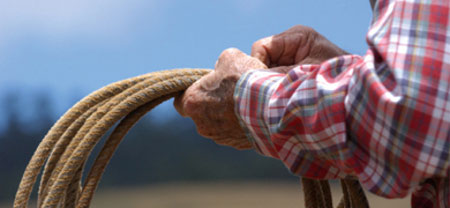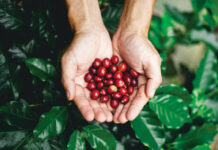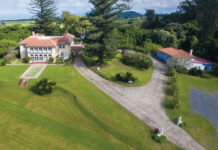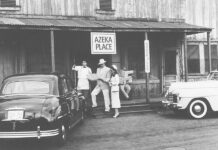Matt Thayer
 Glenn Souza’s voice echoes through the crisp Kula morning air as he leads a herd of Haleakala Ranch cattle through a grove of towering eucalyptus trees.
Glenn Souza’s voice echoes through the crisp Kula morning air as he leads a herd of Haleakala Ranch cattle through a grove of towering eucalyptus trees.
Following the paniolo’s soulful call of “come on,” the cattle track the cowboy and his horse through the trees and across rolling meadow on their way to fresh pasture. The morning drive is slow and easy, a mostly stress-free walk in the park for momma cows and their babies. Only laggards and troublemakers need answer to a trailing cowboy and his team of well-trained cattle-herding dogs.
By raising stock with low-stress lives spent entirely on Maui, and free of growth hormones and antibiotics, Maui Cattle Company is learning to turn tender, loving care into tender, succulent beef. The company’s blend of cutting-edge ideas with tried-and-true techniques offers new hope for the future of commercial ranching on the island.
Maui Cattle Company is a consortium of ranches that includes Haleakala, ‘Ulupalakua, Kaupo, Hana and Nobriga Ranches on Maui, and Olumau Ranch on Kaua‘i. The businesses’ cooperation and financial commitment give the resulting company enough wallop to implement two plans for success that are nearly as old as business itself—produce a better product and eliminate the middle man.
For years, Maui ranches raised plenty of cattle, but very little of that beef made it to Maui tables. Conventional wisdom said it was cheaper to ship young stock to Mainland feedlots where it could be fattened up to match America’s tastes and standards. It takes about 650 pounds of feed to add a final 100 pounds of marbling to each head of cattle. “Marbling” is a fancy way of saying “fat,” and that is what the steers became while spending their final months in small paddocks with thousands of other head.
Maui Cattle Company Managing Director Alex Franco says it is time to change that thinking. “The goal is to have a cattle industry here for the next generation. In order to save our business we need to take a big step forward and process and market our own beef. We need to bring that back to the ranches so we can become sustainable.”
Currently, about a third of the 5,000 head of cattle sold by the ranches each year is processed on Maui. Franco says the goal is to expand sales of Maui Cattle Company beef in Hawai‘i so that most or all of those cattle do not need to be shipped live to the Mainland. Expanding market share on O‘ahu is a priority.
“Basically, if we don’t make these kinds of moves, and Maui-based agriculture doesn’t make these moves, so [that] all the money stays here on the island, then agriculture on Maui is going to have a rough time,” Franco says.
While Mainland packing plants may process up to 2,000 animals in just one daily shift, Maui Cattle Company butchers about thirty-five beeves a week in its 2,400-square-foot, USDA-approved facility in Kahului. A new, 12,000-square-foot processing facility is scheduled to be built in Kïhei. Franco says by working with smaller numbers, his company can offer a healthier, tastier cut of meat.
Dry aging is one example where it is better to be the little guy. Franco says his company takes the time to hang its meat for two weeks at about thirty-nine degrees. (Most big plants only have time and space to age beef for two days.) The extra aging adds flavor to the meat that Maui consumers and some of Hawai‘i’s top chefs appreciate.
Celebrity Chef Alan Wong, who has built a reputation with his mastery of Hawai‘i Regional Cuisine, serves Maui Cattle Company beef at his award-winning Honolulu restaurants. Wong says that while people enjoy the taste, he appreciates the opportunity to support local business.
“It’s a great product, it’s a local product and it’s a local business,” says Wong. “I think part of our mission here is to give our guests a slice of Hawai‘i. When we serve the products that are grown or raised in Hawai‘i, we are giving them a taste of Hawai‘i. We need to think sustainability for the ranchers and farmers.”
Wong says Maui Cattle Company beef stands up to competition across America.
“The taste is very good. I’ve taken that beef all over the United States. I do chef events all over the country and people enjoy it.”
Turns out, it’s simple to grill a great steak the Wong way.
“We use kiawe wood in our restaurant,” Wong says. “When you put a nice juicy steak on a kiawe fire, you can’t beat that. All you need is a little salt and pepper.” One of his popular dishes is grilled beef fillet served with goat-cheese mashed potatoes. The cheese comes from a Big Island goat-dairy farm in Hamakua.
Island restaurants like Wong’s make up about 60 percent of Maui Cattle Company’s sales. The all-natural beef is on the menus of more than fifty Maui restaurants, including Roy’s Kïhei, Roy’s Kahana Bar and Grill, Hali‘imaile General Store, Peggy Sue’s, Hotel Hana-Maui, Maui Prince Hotel, 808 Café, Mixed Plate, Stella Blues Cafe, Aroma D’italia Ristorante, Hula Grill, and Bentos and Banquets.
Hula Grill Operating Partner Peter Merriman also sometimes features the beef at two eateries he owns on the Big Island. “I love their beef,” Merriman says. “For the healthful aspects, I choose Maui Cattle Company every time.” His reasons? “Number one is quality and number two is I want to do everything I can to help them succeed. We’ve got to keep seeing cowboys in Hawai‘i, don’t we?”
Home chefs who would like to grill the meat can find it at most of Maui’s independent stores. Steaks, boneless ribs and hamburger are vacuum-sealed in plastic packages that have a gold-and-silver-foil backing. A no-nonsense label of “Island Beef” is pasted on the back. Outlets include Longs Drugs, Morihara Store, ‘Ulupalakua Ranch Store, Pukalani Superette, Rodeo General Store, Hanzawa Store, Hasegawa Store, Hana Ranch Store, Mana Foods and Ah Fook’s Super Market.
One loyal customer is Kihei bike shop owner Frank Hackett. As a father raising three growing boys, Hackett says he appreciates what the meat doesn’t have as much as what it does. “I regularly buy the hamburger for my kids,” Hackett said. “If you are going to give them hamburger, that’s the kind to give them. There are no antibiotics and no growth hormones. It tastes better and it is competitively priced. I love that the meat it is so good and it is good for you.”
Franco says Maui ranches are betting their future that customers like Hackett will cause enough demand that all island cattle will eventually be processed locally. “If a person is concerned with where their food is coming from, we meet that demand,” he says. “The other competitors, I don’t want to bad-mouth them. They provide a very safe and good product, but you may be eating a piece of beef that originated in Florida or Washington. You don’t know. With us, you know what ranch they came from, when they were harvested, and the breeding of the animal.
“We control the cattle from inception all the way to our customers. . . .” Using genetics provided by bulls from Maui and Kaua‘i’s Olumau Ranch, the company concentrates on breeding stock for flavor rather than size. The goal is to determine the best cattle for Maui conditions and consumers.
“We continue working on the genetic base of our program,” says Franco. “We have selected some Angus cattle that are more moderate in size. They tend to have more flavor, as opposed to those cattle that have a lot of growth.”
Haleakala Ranch Manager Greg Friel says he sells about half of his yearly crop to Maui Cattle Company. As the price of doing business skyrockets, he sees the consortium as perhaps the only path to a bright future. “In 1994 it cost me $92 to ship a 500-pound steer to the West Coast. This past spring it cost me $195. Those costs for transportation keep going up, and they are never going down.
“Pretty much, [Maui Cattle Company] may be our only hope.”
Hawai‘i would be a far different place without real cowboys riding herd though Upcountry pastures. Their colorful history stretches back nearly 200 years.
Captain George Vancouver brought the first cattle to the Big Island in 1793 as a gift to King Kamehameha I. A kapu (ban) protected the beasts from slaughter and they soon multiplied. Thirty years later, Hawai‘i saw its first cowboys, vaqueros brought to Parker Ranch from Spanish California in 1823. The Spaniards were called españoles and that eventually became paniolo.
These days, the cowboy culture is celebrated statewide with rodeos, parade entries, big trucks and belt buckles. At the heart of the hoopla is a small collection of hard-working men and women who are probably not much different than generations of other island cowpokes that preceded them.
Soft-spoken, these folks generally let their actions do the talking. They seem most comfortable when they are in the saddle, riding through the mists and across the open pasture; riding away from the cars and lights and people.
Tight economies and new ranching styles mean there are fewer paniolo in daily operations. But when it comes time for a branding, it’s like the calendar has been turned back 100 years. Cowboys from ranches around the island converge with old timers, kids and a few curious spectators for a real-life rodeo. It’s a genuine slice of Hawai‘i life served up loud and dusty.
For cattle accustomed to a stress-free lifestyle, branding day is likely the toughest time they will endure. They are roped, mugged, branded, castrated and inoculated, all in about a minute, necessary duties that are performed as quickly as possible. Franco says the rest of the animals’ lives are designed to have as little stress as possible—from the moment they are born until the moment they are slaughtered.
“We have a set protocol that we insist our partners follow,” Franco says. “We handle our cattle humanely. We’re not moving thousands of cattle a day. We can give more care to the cattle and make sure they are not stressed. All of that leads to higher quality.






I wish we could get “real” Korean-style “big bone” short ribs for kalbi here on Oahu. You just can’t find them. I don’t care for LA style kalbi. If you know of any market or butcher shop on Oahu that sells big bone short ribs, I’d like to know.